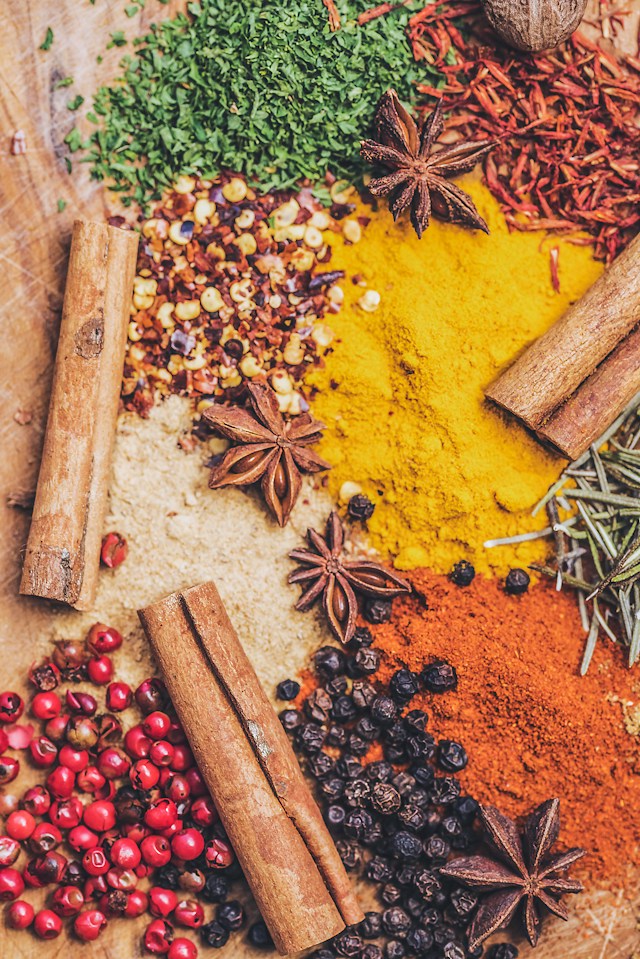How do you create a perfectly balanced spice blend?

Creating the perfect blend of spices is an art that is as much about the balance of flavors as it is about the individual ingredients. Each spice has its unique profile, and a deft touch can transform a simple dish into a culinary masterpiece. Let’s talk about the techniques and tips to create your unique, homemade spice blends.
Understanding your spices
Before diving headfirst into creating your blend, it’s important to understand the spices you are working with. Every spice – from ground cumin to dried thyme – brings a different flavor, aroma and heat level to the mix.
A lire en complément : How to make authentic chinese sweet and sour chicken?
Spices can be categorized into several different groups based on their flavor profiles. The main categories include sweet, pungent, tangy, hot, and bitter. Sweet spices like cinnamon and nutmeg add a hint of sweetness and warmth to your blend. Pungent spices like garlic and onion powder pack a strong, sharp flavor. Tangy spices such as sumac and amchoor (dried mango powder) add a sour or tart note to your mix. Hot spices like cayenne and black pepper bring heat, and bitter spices such as turmeric and fenugreek add a level of complexity to your blend.
Understanding these categories will help you create a balanced blend. You wouldn’t want a blend that is too sweet or too spicy. The perfect blend will have a balance of all these flavors.
Dans le meme genre : What’s the secret to delicious homemade granola bars?
Knowing when to add salt
Salt is a crucial part of any seasoning mix. It enhances the flavors of the other ingredients, making them more pronounced. However, how much salt to add depends on the recipe and your personal preference.
As a general rule, you should start with a 1:1 ratio of salt to spices. This means if you have one teaspoon of combined spices, you should add one teaspoon of salt. However, this might change depending on the blend and the dish you’re using it for.
For instance, a chicken rub might require more salt because it needs to penetrate the meat and add flavor. On the other hand, a spice blend for a vegetable dish might require less salt because vegetables absorb salt more easily than meat.
Creating your own spice blend
Now that you have a basic understanding of spices and salt, it’s time to create your own blend. Firstly, decide on the primary flavor you want for your blend. The primary flavor is the one that stands out the most in your blend. This could be anything from a hot spice like chili to a sweet spice like cinnamon.
Once you’ve chosen your primary flavor, add secondary flavors that complement it. These secondary flavors should be less potent than the primary but still add complexity to your blend. For example, if your primary flavor is cumin, you could add coriander and paprika as secondary flavors.
For extra depth, add a few pinches of a strong, pungent spice like black pepper or mustard seeds. This will give your blend a kick and make it more interesting.
Perfecting your blend
Perfecting a spice blend requires trial and error. It’s essential to taste your blend and adjust the quantities of the spices until you are satisfied with the flavor profile.
One way to test your blend is to cook a small portion of food with it. This will give you a better idea of how the spices will interact with other ingredients. You can then adjust the spices based on how they taste in the dish.
Another tip for perfecting your blend is to let it sit for a day or two before using it. This allows the flavors to meld together and develop.
Remember, the goal is not to create a blend where you can identify each individual spice but rather a new, unique flavor that enhances your food.
Storing your spice blend
Storing your homemade spice blend properly is crucial to maintaining its flavor and potency. It’s best to store your blend in airtight containers and keep them in a cool, dark place.
Avoid exposing your spices to heat, light, and moisture as these can cause them to lose their flavor and potency. Also, remember that ground spices lose their flavor quicker than whole spices. Therefore, it’s best to use your homemade spice blend within six months.
Creating your perfect spice blend can seem daunting, but with patience and a bit of creativity, you can make a blend that adds a unique flavor to your dishes. Experiment, have fun and enjoy the process. Who knows, you might just create the next big thing in the world of spices!
Exploring Different Types of Spice Blends
With the foundations established, it’s time to explore different types of spice mixes you can create. The possibilities are almost limitless. From a mouth-watering steak seasoning to an aromatic Italian seasoning, every blend brings in a whole new world of flavors to dishes.
One popular spice blend is taco seasoning, which usually contains chili powder, ground cumin, garlic powder, onion powder, red pepper flakes, oregano, paprika, salt, and black pepper. This blend is versatile and can be used not only for tacos but also for other Mexican dishes or even as a dry rub for meats.
If you are a fan of Middle Eastern cuisine, a blend like Za’atar – a mix of sesame seeds, sumac, dried thyme, and salt – might be your go-to. This seasoning mix is used in a variety of dishes, from flatbreads to salads to roasted vegetables.
For those with a sweet tooth, pumpkin pie spice blend can transform your baking. Comprising cinnamon, ginger, nutmeg, and cloves, it adds warmth and depth to pies, muffins, and other desserts.
Creating your homemade spice blends allows you to play with flavors and adjust them to your liking. Want your taco seasoning less spicy? Reduce the amount of chili powder. Prefer your Italian seasoning with more rosemary? Add an extra pinch.
The Magic of Seasoning Blends in Cooking
Spice blends can elevate your cooking to a whole new level. They can transform a plain steak into a juicy, flavor-packed meal or a simple vegetable stir-fry into a savory delight.
For example, a dry rub made from your unique spice blend can add depth of flavor to your meat. Simply rub the mix onto the meat and let it marinate for a few hours or overnight before grilling or roasting.
Seasoning blends also work wonders in vegan and vegetarian dishes. They can add layers of flavor to pulses, grains, and vegetables, making them taste delicious without the need for meat or dairy.
One great thing about making your own spice mixes is that you can tailor them to suit your dietary needs. For instance, if you’re watching your sodium intake, you can create a salt-free blend. Or if you’re allergic to a certain spice, you can simply leave it out.
Remember, when using your spice mix, add a little at a time. You can always add more, but you can’t take it out once it’s mixed in.
Conclusion
Creating the perfect spice blend is indeed an art. It requires a thorough understanding of the characteristics of each spice, a clear vision of the flavor you want to achieve, and a willingness to experiment and adjust until you find your perfect balance. Whether it’s a robust steak seasoning, a versatile Italian seasoning, or a warming pie spice mix, the right blend can elevate your cooking and impress your guests.
Remember to store your blends correctly to preserve their potency. A cool, dark place is ideal for storage, away from exposure to heat, light, and moisture. Enjoy the journey of creating your own homemade spice blends, and let your creativity shine through your cooking. Happy blending!
